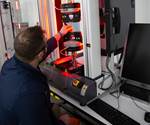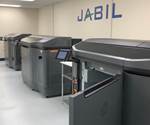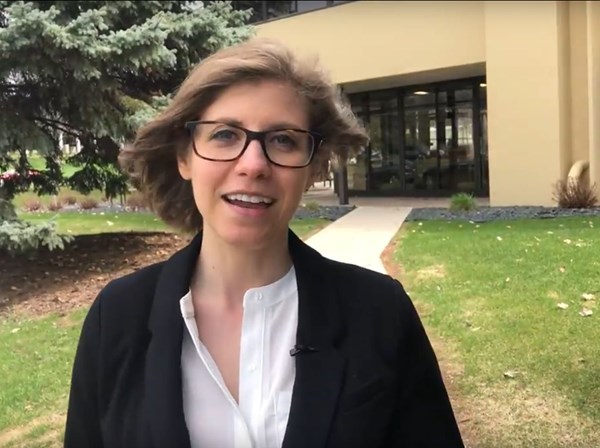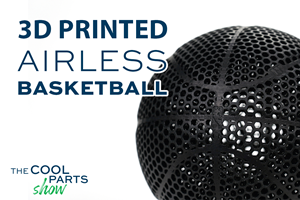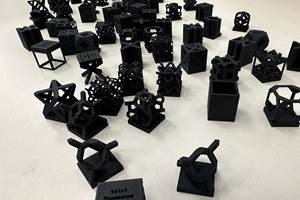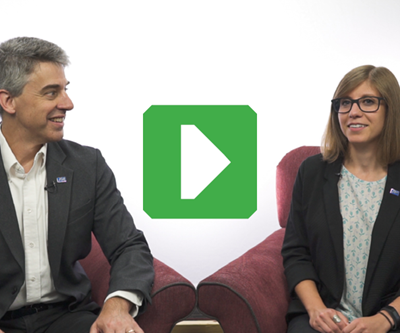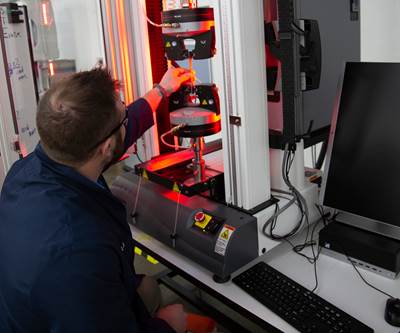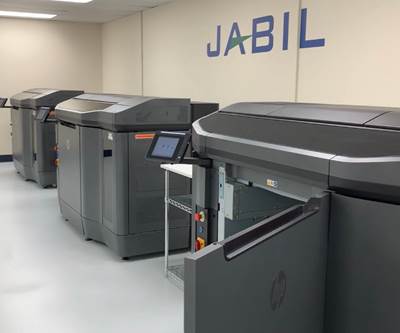10 Questions About Additive Manufacturing for Production with Jabil’s John Dulchinos
“We’re in this for the long haul,” he says. Here are the challenges facing 3D printing for production, and here are the ways those challenges will be overcome.
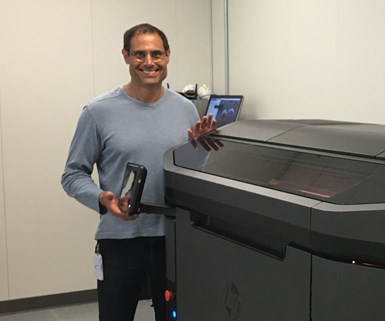
John Dulchinos is Jabil’s VP of 3D printing and digital manufacturing. Describing the company’s view of AM, he says, “We’re in this for the long haul. And we’re in early because we see that it will be transformative.”
What will additive manufacturing (AM) mean for an established international manufacturing solutions provider? Jabil, one of the world’s largest contract manufacturers, produces parts and products for well-known OEMs across various industries. It runs about 15,000 CNC machine tools and 4,000 injection molding machines in sites around the globe, and now has invested to add additive manufacturing capacity as an additional production resource at various locations. The company has also opened a new Materials Innovation Center in Minnesota dedicated to developing materials for AM, to support the volume and variety of production AM the company expects to do.
I recently spoke with John Dulchinos, Jabil’s VP of digital manufacturing, for his view on what additive manufacturing means today and will mean for the future of the company.
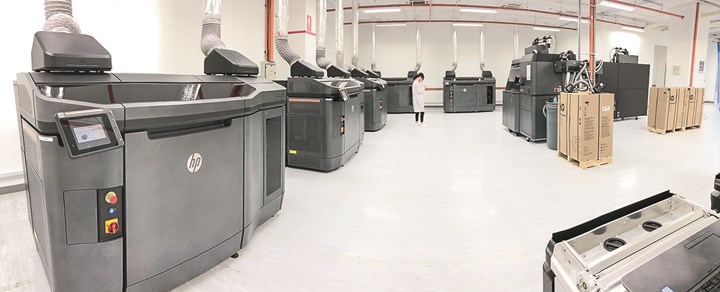
At a Jabil site in Singapore, parts go straight from 3D printing into assembly without any need for shipping or storage in between. “It’s a more elegant way to produce,” Dulchinos says.
1. Describe AM for production as it’s playing out for Jabil right now. What benefits are you achieving?
Dulchinos: A great example is production we’re running in Singapore. We have the assembly operation for one of our customer’s products upstairs, and we’re 3D printing parts that go into it downstairs, printing them for the assembly line as needed. So it’s a tight supply chain. We expect to do a lot of that: make production parts not necessarily to get shipped as parts, but to be assembled into other products. When we run this way, basically there are no shipping costs, no packaging costs, no shipping time for the component parts — we just take them off the printers and put them into assembly. Instead of building to inventory, we build to production. It’s a more elegant way to produce.
More on Additive Manufacturing for Production at Jabil
Additive Manufacturing has reported from the new Materials Innovation Center (left) and a Jabil plant in Michigan equipped for production 3D printing. Find these articles and more at gbm.media/jabil.
2. What role will AM play for Jabil? How will you advance it?
Dulchinos: We’re in a great spot, because the 3D-printing-focused companies tend to have a single motivation, which is to produce a 3D-printed part. In Jabil’s case, we are a very large molder and a very large metalworking operation, so we really don’t care, fundamentally, which processes a job needs. To us, 3D printing’s just another tool in our toolbox. It allows us to deliver a different manufacturing solution for a customer. Where this capability makes sense, we can use it to provide a lot more design freedom. We can give the ability to produce products without tooling, and to consolidate assemblies into single parts. All those things are advantages that 3D printing has over conventional processes.
3. Is AM cost-competitive with conventional processes?
Dulchinos: Today, the economics are not as advantageous to scale as traditional manufacturing processes. But it’s likely there will be some kind of Moore’s Law with 3D printing letting it get better every year by a steady multiple. I think we’re seeing exactly that. It used to be a breakeven point for 3D printing was in hundreds of parts, then thousands of parts, now tens of thousands of parts, and on from there. We’re in this for the long haul. And we’re in early because we see that it will be transformative.
4. What do you need to do as a manufacturing solutions provider to help AM find its opportunities?
Dulchinos: The real balance that we bring relates to how there isn’t a well-established supply chain for additive. To really take advantage of 3D printing as a tool, you need to leverage the design freedom. If you don’t design for 3D printing, it’s going to be hard to justify it. But engineers aren’t ready to design for it because they don’t trust the supply chain. And they don’t have a deep understanding of the allowables that 3D printing provides. So we’re all about how to qualify it, how to certify the manufacturing process is solid, repeatable and trusted. There’s a lot of work we’ve been doing to take what is still a relatively immature technology and develop the process rigor and the qualifications around it so we can trust what comes out the back end.
5. Talk about Jabil’s new materials center in Minnesota. What is the challenge related to materials in AM?
Dulchinos: In the case of polymers, AM right now is not like injection molding. Take nylon: There must be hundreds or thousands of different derivations in conventional manufacturing. In 3D printing, there are probably three or four. So we developed the Materials Innovation Center in Minnesota to allow us to do all those iterative versions of materials at a fast pace, turning out a new material within two or three weeks. In Minnesota, we can start with beakers and flasks and chemistry sets on one end and get filament and powder on the other end, all within one environment. We have all the characterization and we have all the development labs. We can go end to end in the development of the specialty materials, allowing us to serve our customer at a fast pace.
6. Why is the materials facility so important?
Dulchinos: Materials are one of the biggest shortcomings right now in industry’s use of 3D printing. So we kicked off establishing this facility last year. We stood up a complete greenfield operation in a 15-month period. Getting all the equipment in, hiring people, getting the building finished, getting all the processes done, getting the facility certified to ISO 9001 — it’s remarkable. And with the capabilities that are in here, this is maybe one of a few facilities like this in the entire world around additive. There are many steps to get from a formulation to a finished product; the real advantage we have is we’ve integrated all that under one roof. Normally you would do a process step by sending it out and having somebody do something to it and getting it back. Then I need to analyze it, make some changes, send it back out and it’s a very iterative process. We can do that all in-house — we have all the characterization in-house, we have all the chemical processing in-house. So we do a derivative, take it down the hall, do the testing, come back and make a change, go back. We can go through the process so much faster than you would in a traditional way.
7. What are the kinds of materials needs the facility will help Jabil address?
Dulchinos: It’s the little things that make a difference. We supply material to parts for a producer associated with a particular color. This customer has a very specific color they like. We created a polymer for them that was good and had their color, their specific shade. At the end of the day, could they have lived with something that wasn’t exact? I don’t know. Functionally, sure. But from a marketing standpoint, probably not.
There are lots of applications in automotive where you could use a thermoplastic polyurethane (TPU). There are also lots of applications in consumer products like footwear where you might want to use a TPU. The TPUs that footwear customers want have fundamentally different characteristics than the TPU you’d use in automotive, so there’s a range of variation you could create in and get just the right response for the application compared to what you might do to put it into an automotive interior. Having the ability to tune the material to the right functional requirement is key.
And that’s the thing: We’re not trying to recreate a material like ABS in a pure form. Because the additive version is not going to be exactly the same. What we really want to do is start with one of the functional requirements an application has and figure out some materials that meet those requirements. It’s about, how do you understand the application requirements? It’s the subtleties. Color may seem trivial in some cases, but in this application, it was a key requirement. In another application, it would be getting a TPU with the right response for footwear.
8. Is internal materials development for AM a capability Jabil will no longer need once the materials supply chain for additive grows?
Dulchinos: With additive, we’re in the first or second inning of an extra-inning ballgame. A lot of change will occur over the next decade or two. But we think there will always be a need to take those base polymers and combine them with other polymers or other additives and solve lots of applications in the long tail. I think about additive as being a long tail market for manufacturing in the same way the internet has made the long tail accessible to businesses. Additive, because you don’t have to tool, makes the long tail of production palatable to manufacturing. Additive takes away the cost of servicing the long tail.
"With additive, we’re in the first or second inning of an extra-inning ballgame." John Dulchinos, Jabil - via @AddMfgMedia https://ctt.ac/0_lj0+
9. How does production look different when AM is the process?
Dulchinos: In additive, the cost of making a dozen of the same part, versus 12 slightly different parts, is essentially the same. We’re building families of parts, and it’s just as efficient to do that as to make them all the same. It allows you to serve the customer in a completely different way. You look at traditional business school, you take a class in product management, and it’s all about how do you define markets in ways that you can group a bigger and bigger set of people and serve them with a single product. Apple has three or four phones to serve hundreds of millions of consumers. But if there’s no cost to open that up, just imagine what product marketing people are going to do in the future, when they know that instead of having to jam 100 people in a single market, they could say, “Hey, we’re going to set that up with 10 different markets, because it costs us the same amount of money to serve each one from a manufacturing standpoint.”
Then it starts to really open up a lot more kinds of specialty products. And then you get to the next thing, which is the other aspect of what we’re trying to do: build out and think about this as a network, not as a manufacturing solution. Ultimately, we want to have 3D printing centers more regionally located. Because at the end of the day, once we qualify processes and certify operations, moving production from location to location is trivial. That allows us to think about how to serve customers in the most efficient way, leveraging a global distributed manufacturing footprint.
"In additive, the cost of making a dozen of the same part, versus 12 slightly different parts, is essentially the same..." - via @AddMfgMedia https://ctt.ac/KGdfb+
10. As OEMs increasingly take advantage of AM, how will their possibilities change?
Dulchinos: The real advantage of 3D printing is the chance to take a step back and think systemically about how this design freedom allows you to solve problems in a different way. And it’s a different level of thinking, one that hasn’t been nurtured well in industry as yet, because we’re all focused on driving down to how you get things as streamlined as possible, how you get things to the lowest cost point.
But in 3D printing, you take a step back and say, the design freedom allows me to consolidate all these parts so I can get better airflow through this engine control module, which means I can now put it somewhere else, take up less space. There’s this cascading of design benefits that can come out of 3D printing, to start designing for optimized geometries, that can affect how you think about the more holistic design inside of the car, for example. And that’s a whole different perspective. If you could create a seat that had better airflow, maybe we could create a new kind of cooling or heating system for that seat that creates more comfort. It’s not about just replacing the functional part, it’s about “how does that create a better overall design you could take advantage of?” It’s system-level versus component-level thinking.
Related Content
3D Printed Cutting Tool for Large Transmission Part: The Cool Parts Show Bonus
A boring tool that was once 30 kg challenged the performance of the machining center using it. The replacement tool is 11.5 kg, and more efficient as well, thanks to generative design.
Read More3MF File Format for Additive Manufacturing: More Than Geometry
The file format offers a less data-intensive way of recording part geometry, as well as details about build preparation, material, process and more.
Read MoreAirless Basketball Shows Promise of 3D Printed Lattices: The Cool Parts Show Bonus
Successfully matching the performance of a standard basketball demonstrates the control possible over the mechanical properties of digital materials.
Read MoreVixiv Developing AI Alternative to Generative Design
Newly opened Ohio facility is where geometric cells are made and tested to inform the machine learning system that will “know,” without computation, what 3D printed form satisfies a given set of needs.
Read MoreRead Next
AM at Jabil: From 3D Printing Materials to Distributed Manufacturing
One of the largest manufacturers in the world has made a significant investment in 3D printing — both as a user and an advancer of this technology. Our original reporting dives into the what and why of additive manufacturing at Jabil.
Read MoreJabil’s Additive Materials Innovation Center: First Look
Additive Manufacturing Media was the first press to tour the Chaska, Minnesota, facility originally intended to be a clandestine additive manufacturing (AM) materials lab. What this capacity means for Jabil and 3D printing users.
Read MoreJabil Prepares for Production AM: It’s Down to the Basics Now
Jabil is getting ready for additive manufacturing to take its place as a production option in addition to conventional processes such as molding and machining. AM can and will fill this role, the company says — the focus now is on controlling cost and assuring quality and reliability.
Read More


